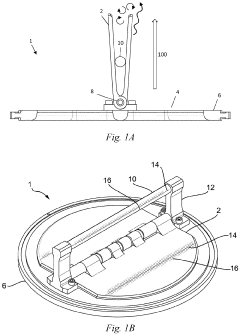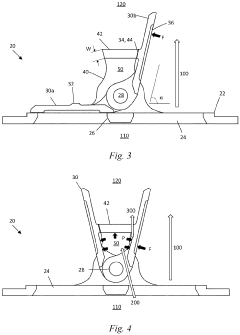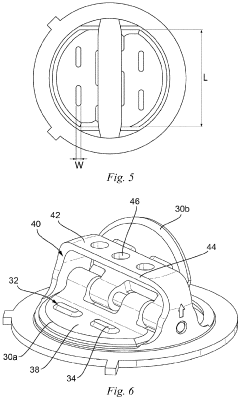Wear And Tear Reduction Strategies For Check Valves
Technology Background And Goals
By examining the latest advancements, patents, and scientific literature in this field, the report aims to uncover promising avenues for minimizing valve degradation and extending their operational lifespan, ultimately benefiting various industries reliant on check valve performance.
Check Valve Market Demand Analysis
- Market Size and Growth
The global check valve market is expected to witness significant growth, driven by increasing demand from industries like oil and gas, chemical processing, and water treatment. Factors like infrastructure development, urbanization, and the need for efficient fluid control systems contribute to market expansion. - Industry Trends
Key trends shaping the check valve market include the adoption of advanced materials for improved durability and corrosion resistance, the integration of smart monitoring technologies for predictive maintenance, and the demand for compact and lightweight designs to optimize space utilization. - Application Segments
Major application segments for check valves include oil and gas production and transportation, chemical processing plants, power generation facilities, water and wastewater treatment systems, and various manufacturing industries. Each segment has specific requirements for valve performance, materials, and certifications. - Regional Dynamics
The Asia-Pacific region is expected to be a significant market for check valves, driven by rapid industrialization and infrastructure development in countries like China and India. North America and Europe also represent mature markets with a focus on replacement and upgrade projects.
Technology Status And Challenges
- Valve Wear Mechanisms
Erosion, corrosion, cavitation, and mechanical impact contribute to valve wear. - Valve Materials
Common valve materials like stainless steel, cast iron, and bronze have limitations in harsh environments. - Valve Design Challenges
Complex geometries, high-pressure differentials, and flow turbulence pose design challenges. - Maintenance Issues
Frequent valve replacements, unplanned downtime, and high maintenance costs are major concerns. - Monitoring Techniques
Condition monitoring techniques like vibration analysis and acoustic emission are used to detect valve wear.
Current Technical Solutions
01 Abrasive Particle Wear
Abrasive particles in fluid flow can cause erosion and damage to valve components, leading to leakage or failure. Wear-resistant materials, coatings, and filtration systems can mitigate this issue.- Fluid Flow Wear: High-velocity fluid flow can cause erosion and abrasion of valve components, leading to leakage or failure over time. Wear-resistant materials or coatings can mitigate this issue.
- Particulate Matter Wear: Particulate matter in the fluid can get trapped between valve components, causing abrasion and erosion. Proper filtration or straining can reduce particulate matter and extend valve lifespan.
- Cyclic Loading Wear: Frequent opening and closing cycles can lead to fatigue and eventual failure of valve components due to repeated impact and friction. Using high fatigue strength materials or reducing impact can mitigate this issue.
- Corrosion Wear: Corrosive fluids or environments can cause valve components to corrode over time, leading to leakage, sticking, or failure. Corrosion-resistant materials or protective coatings can extend valve lifespan.
- Installation and Maintenance Wear: Improper installation, misalignment, excessive tightening, or inadequate lubrication can cause increased friction and wear on valve components. Proper installation and regular maintenance are crucial.
02 Corrosive Fluid Wear
Corrosive fluids can cause chemical degradation and material loss of valve components, leading to erosion and eventual failure. Corrosion-resistant materials, protective coatings, and regular maintenance can address this issue.Expand Specific Solutions03 High-Temperature Wear
High-temperature environments can accelerate thermal degradation, creep, and oxidation of valve materials, resulting in deformation and failure. High-temperature-resistant materials, cooling systems, and temperature limits can mitigate this issue.Expand Specific Solutions04 Cyclic Loading and Fatigue Wear
Repeated opening and closing cycles can lead to fatigue, cracking, deformation, and eventual failure of valve components. Fatigue-resistant materials, optimized design, and preventive maintenance can address this issue.Expand Specific Solutions05 Installation and Maintenance Wear
Improper installation, misalignment, or lack of maintenance can contribute to accelerated wear and tear, leading to leakage, sticking, and premature failure. Proper installation, inspections, and maintenance schedules are crucial.Expand Specific Solutions
Technology Main Player Analysis
Honeywell International Technologies Ltd.
Robert Bosch GmbH
Key Technology Interpretation
- Conformal contact surfaces: the provision of relatively large contact areas due to the conformal contact surfaces allows for the even distribution of stress between the flappers and stop elements. this reduces wear and tear on the components, especially during percussive opening of the valve. the use of conformal contact surfaces ensures that the stress is evenly distributed, preventing localized wear.
- Bumpers and adjacent openings: the inclusion of bumpers and adjacent openings in the valve design facilitates smooth opening and closing of the valve. these elements help reduce fluttering and percussive opening events, which can cause wear and damage to the contact surfaces. by minimizing these events, the valve can have a longer lifespan and reduced maintenance requirements.
- Static stop element: the provision of a static stop element with contact surfaces configured to be stationary (e.g. non-resilient) further prevents positional fluctuations of the flapper when in the open position. this additional stationary stop element further reduces wear on the contact surfaces and the pin of the hinge. the use of a static stop element ensures that the flapper remains in a fixed position, preventing any unwanted movement that could cause wear.
- Synergistic effect: the combination of conformal contact surfaces, bumpers, and static stop elements that are configured to remain stationary (rather than bend or flex in use) provides a synergistic effect. this ensures that wear on the contact surfaces is minimized, preventing wear on the pin of the hinge and reducing wear on the contact surfaces themselves. by preventing wear, the valve can have a longer lifespan and require less maintenance, resulting in cost savings for the organization.
Check Valve Wear And Tear Reduction Economic Analysis
When analyzing the economic aspects of reducing wear and tear in check valves, it's essential to consider both direct and indirect financial implications for relevant industries, such as oil and gas, water management, and chemical processing, where check valves are prevalent. Direct cost benefits include reduced maintenance expenses due to longer-lasting components, translating to decreased downtime and extended operational periods. Efficient check valve technology can lead to lower energy consumption by minimizing resistance and promoting optimal flow, directly impacting operational costs.
Indirectly, the implementation of enhanced check valve technology can lead to longer asset lifecycles, reducing the frequency and need for capital expenditure on replacements. Furthermore, as industries move towards sustainable practices, innovations that enhance the durability of check valves may also contribute to meeting regulatory standards, potentially avoiding costly compliance penalties.
Cost-benefit analysis must also account for potential market positioning advantages gained through increased reliability and perceived quality improvements. Ultimately, investing in advanced check valve technologies can deliver substantial economic advantages by improving efficiency, reliability, and sustainability, supporting a company’s long-term financial strategy.



